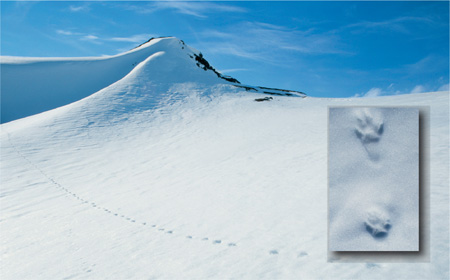
Alopex lagopus
Tracks of an Arctic Fox in the Norwegian mountains—a rare sight. RM.

The Arctic Fox is somewhat smaller than Red Fox, with shorter snout, tail, and ears, and sturdier legs. The height at the shoulder is about 30 cm and length is about 55–65 cm; the tail is about 30–55 cm long, Arctic Fox normally weighs about 3–5 kg but may weigh up to 8 kg.
An Arctic Fox in its summer coat. HS.

The Arctic Fox is also known as the Snow Fox, and has two colour morphs; in the summer, the blue morph is grey-brown; in the winter, it is darker, grey-black to dark brown, and almost blue. The white morph is grey-black on the back in the summer, and grey-white on the sides and underbelly. The winter coat is pure white. The Arctic Fox lives in high mountain regions above the treeline. In years with plentiful cubs, individuals may also move into lowland areas. On Svalbard and Iceland, it may also be seen in the coastal regions, where it feeds on flotsam, fish, and crabs, as well as seal and whale carcasses. Like Red Fox, the Arctic Fox is territorial and lives in family groups. In the mountains it feeds mostly on small rodents, lemmings for instance, as well as birds and their eggs and young, but also on Reindeer carrion. In the summer it also eats berries. The Arctic Fox is active both day and night but most easily seen at dusk.
Arctic Fox cubs in their summer coats, two white and a blue morph. TSC.

The tracks are smaller and more rounded than those of Red Fox, 5–6 cm long and similar to the tracks of a small dog. In winter you see only faint pad prints, since the feet are covered with hair. The claws of the inner toes point inward; the stride is also shorter than that of Red Fox. Arctic Fox moves less at a trot, making more short jumps in the gait, and the prints of all four feet are quite visible. The length of the stride is about 70–100 cm.
The Arctic Fox digs a large den in the open mountain landscape, often with various levels and exits. Prey are carried into the den; when the remains are combined with scat, the earth is well fertilised, and as a consequence, vegetation surrounding the den is often lush and easily visible.
The scat of Arctic Fox resembles that of Red Fox, but is smaller, 1–1.5 cm thick and 5–10 cm long and, because it contains the hair of prey, often grey.
